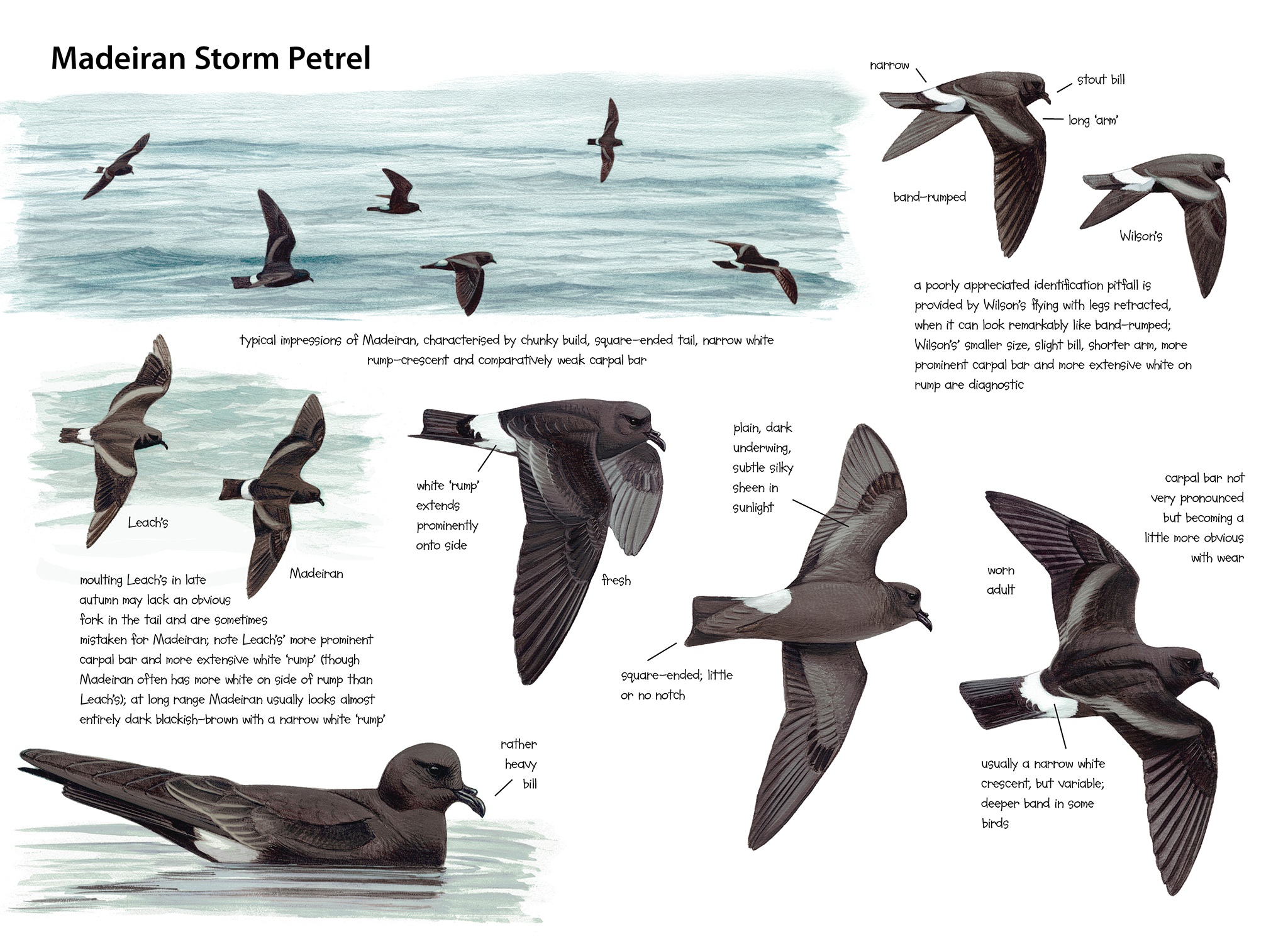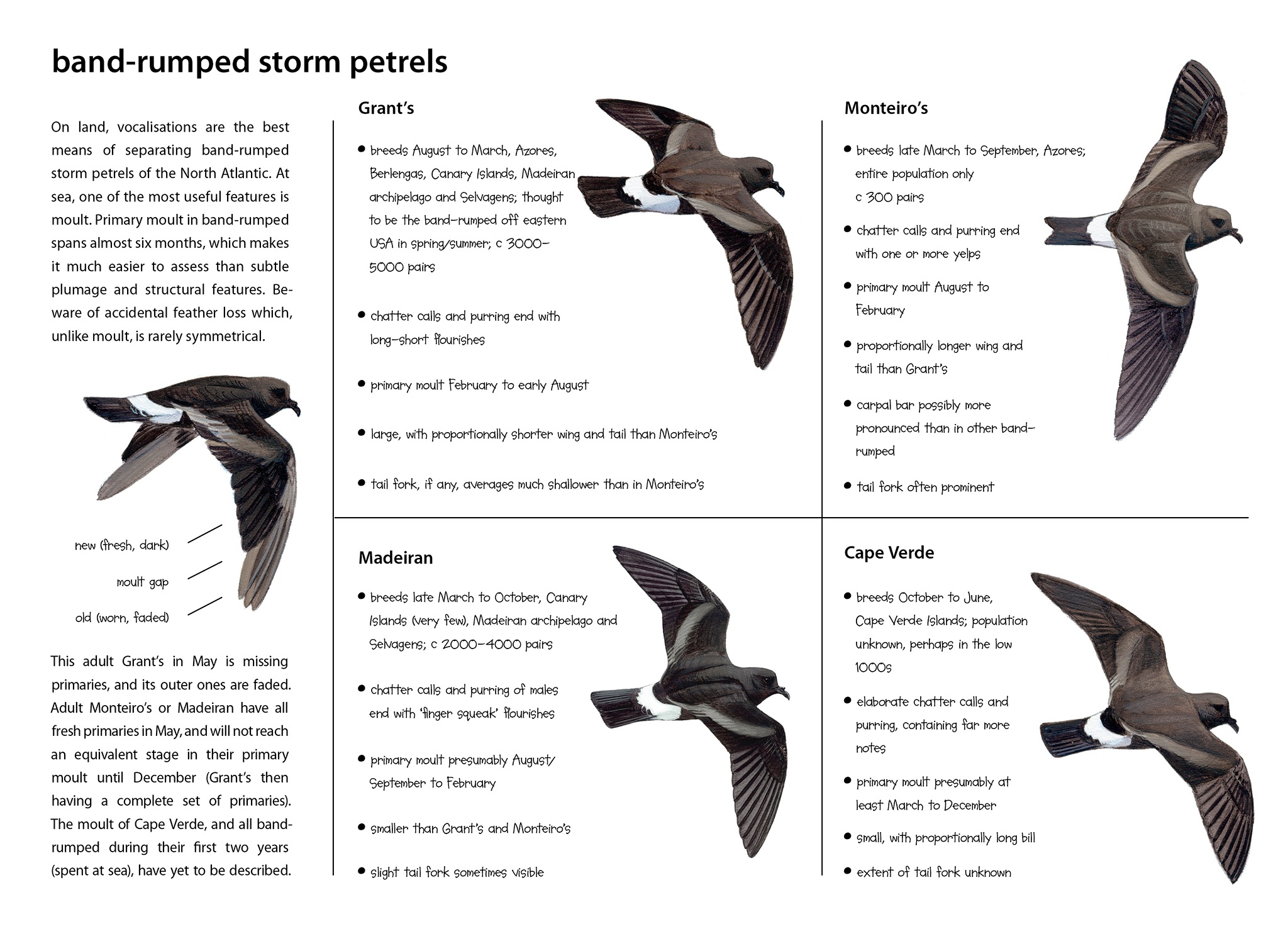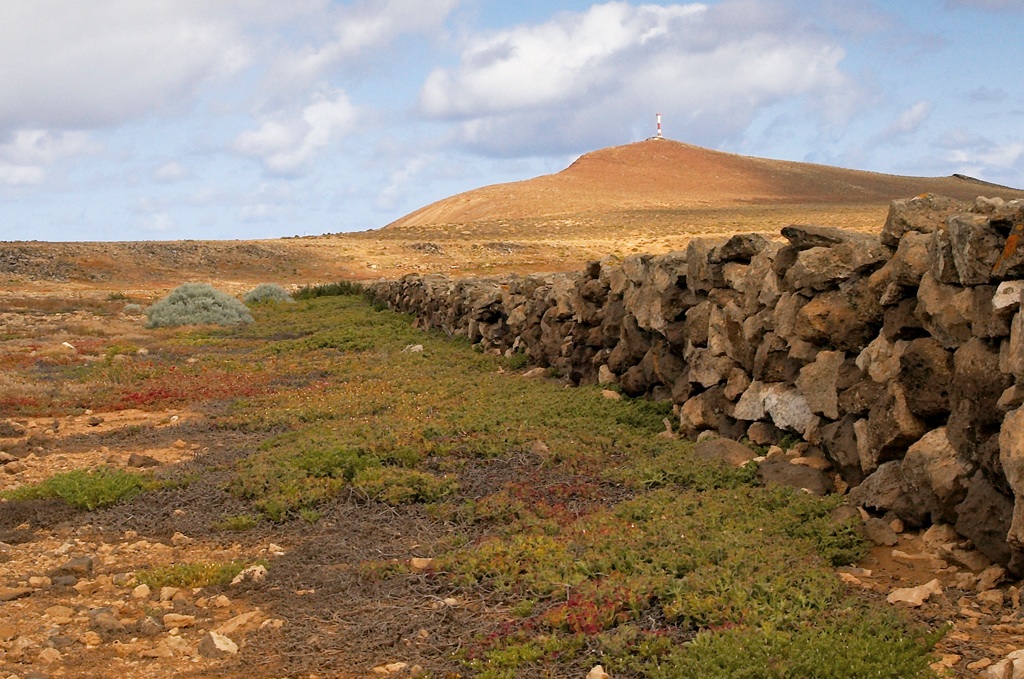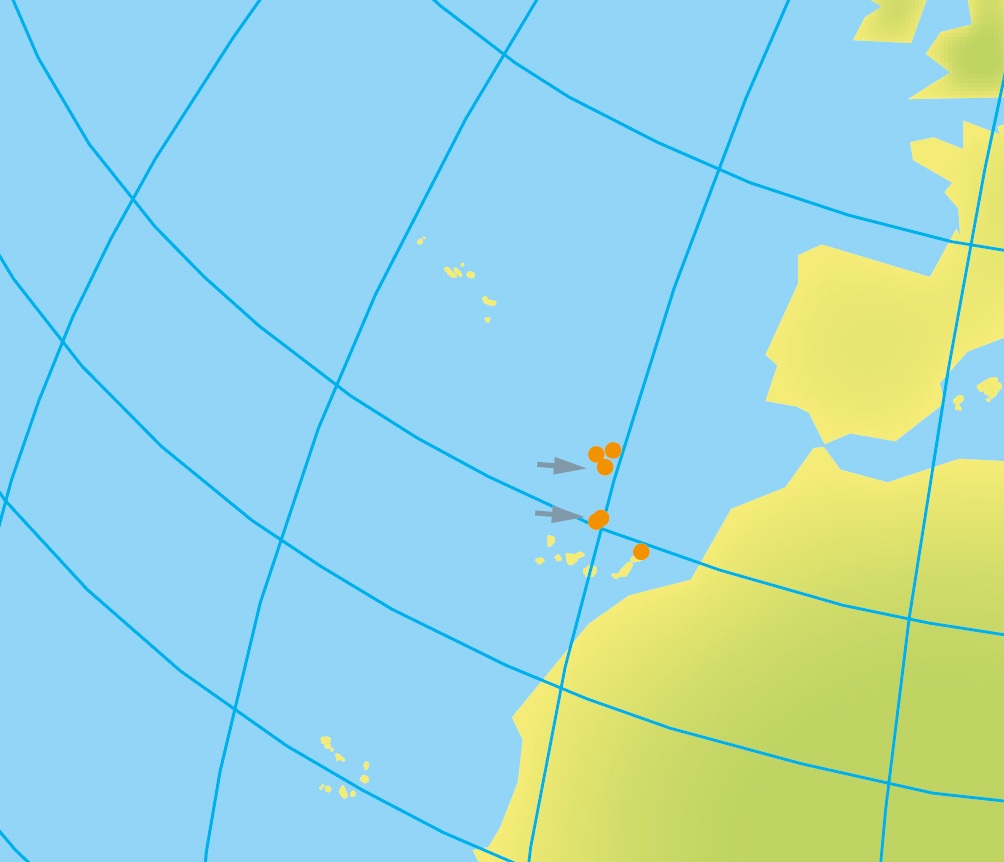Starting in the late 1980s, the young Portuguese scientist Luís Rocha Monteiro studied mercury pollution in the marine environment of the Azores. After a few years, he recruited the help of seabirds. From mercury concentrations in their plumage and regurgitations of food, he was able to infer the health of the rest of the ecosystem. Among the birds he studied were band-rumped storm petrels Oceanodroma, which had only recently been proven to breed in the Azores.
Monteiro soon discovered that there were two populations in the islands, one present in the hot season (March to September) and the other in the cool season (August to March). During the early autumn, adults of the cool-season population could often be found in the very same burrows where nestlings of the hot-season population were still growing up. Striking differences in their mercury levels led Monteiro to believe that the two populations might differ in their feeding ecology, and subsequent research showed that they also differed in morphology and egg dimensions. Hot-season birds were smaller in most body measurements, particularly weight, but had longer tails, and proportionally longer wings. A detailed paper was published, raising the exciting possibility that hot- and cool-season populations in the Azores might be cryptic species (Monteiro & Furness 1998). Tragically, Monteiro never had the opportunity to follow the story through. He died in a plane crash on the island of São Jorge in December 1999, when he was still in his late 30s.
Eight years after his death, the dust is still far from settling over Monteiro’s discovery, and the number of different types of band-rumped storm petrel in the North Atlantic has risen to four. They form a classic example of a group of birds whose diversity went unnoticed due to similarity in plumage, despite differences in measurements, the timing of their annual cycle, and DNA. For us it has been a real adventure obtaining sound recordings of each band-rumped and listening to vocal differences. These are so clear that they readily support any appeals for an increased level of conservation for each one. Collectively, they can be referred to as ‘band-rumped storm petrels’. Madeiran Storm Petrel O castro is the hot-season breeder of the Madeiran archipelago, Selvagens and the Canary Islands. Cape Verde Storm Petrel O jabejabe breeds only in the Cape Verde Islands. Monteiro’s Storm Petrel is the hot-season breeder of the Azores, named after its discoverer Luís Monteiro; a formal description of this new taxon will be published shortly (Bolton et al 2008). Grant’s Storm Petrel (not yet formally described) is the cool-season breeder of the Azores, Berlengas, Canary Islands, Madeiran archipelago and Selvagens. This name was suggested by Steve Howell in conversation, in memory of the late Peter Grant who died in 1990.

Killian Mullarney

Killian Mullarney
Text by Magnus Robb.
present as a breeding bird from March to October in the Canary Islands, Madeiran archipelago and Selvagens.
In the Selvagens, Madeiran Storm Petrels are far more noticeable to the ear than the numerous but silent White-faced Storm Petrels Pelagodroma marina. Madeirans usually like to breed in small crevices among rocks, so the many dry stone dykes are just about perfect. On Selvagem Pequena, they have also discovered the comforts of burrows dug in the sand by White-faced, establishing a presence on steeper ground at the edge of their colony. This was where I recorded aerial displays of Madeirans on 26 June 2006, about two hours after sunset. Within a limited area, not far from the surf, several male Madeirans were chatter calling in flight (CD2-53). I lay on the path nearby, hardly daring to move, for fear of damaging a fragile burrow. The windward shore of the island was not far away, and the sound of surf was quite strong. Madeirans were flying just over my head, and in the darkness of new moon, their activity was probably at its height.
CD2-53: Madeiran Storm Petrel Oceanodroma castro Selvagem Pequena, Selvagens, 23:02, 26 June 2006. Males chatter calling and giving brief aerial purring calls. Background: Cory’s Shearwater Calonectris borealis and surf. 060626.MR.230233b.02
On hearing them in the Desertas in July 1939, Ronald Lockley described Madeiran Storm Petrels “flying about the island after dusk, calling with a soft squeaky note exactly like a finger rapidly rubbed hard on a window pane” (Lockley 1951). This quality can be heard best in the diagnostic flourishes at the end of both their chatter and purring calls. Male Madeirans have only one, sometimes two of these flourishes in their chatter calls, with their characteristic, squeaky tone. Most of the calls in CD2-53 have just one flourish, but examples of double ones can be heard in CD2-54, recorded on Selvagem Grande. Monteiro’s Storm Petrels have up to three loud flourishes at the end, and these have more of a yelping quality. The middle section also differs between the two hot-season storm petrels. Monteiro’s has no more than one short note in the middle, often more or less joined to the first of its yelps, while Madeiran has up to three separate notes in the equivalent position.
In colonies where Madeiran Storm Petrels normally occur, the only species you are likely to confuse them with is Grant’s Storm Petrel. Madeiran are present from at least April to October, and Grant’s from August to February or March, so they overlap in early autumn. The key thing to listen for is the diagnostic ending of the chatter call. In Grant’s, as you may remember, each chatter call usually ends with a diagnostic l o n g – short, l o n g – short rhythm that can be memorised as au-tumn, au-tumn. This is completely different from the window-pane squeak of Madeiran, which when doubled has a rhythm closer to spring, spring!
Chatter calls of male and female Madeiran Storm Petrels are similar in rhythm and emphasis, but females sound much harsher, a difference confirmed by James & Robertson (1985e). You can hear some females in CD2-55, which were attracted to a male purring in a crevice, up on the windy plateau of Selvagem Grande. Several females called loudly as they fluttered to and fro over his burrow. As it turned out, there was a female inside too, and you can hear her chatter calling at 0:23 and 1:05.
CD2-54: Madeiran Storm Petrel Oceanodroma castro Selvagem Grande, Selvagens, 28 June 2006. Males chatter calling in flight. Background: Cory’s Shearwater Calonectris borealis and Bulwer’s Petrel Bulweria bulwerii. 06.008.MR.10729.01
CD2-55: Madeiran Storm Petrel Oceanodroma castro Selvagem Grande, Selvagens, 28 June 2006. Male purring in a burrow under a slab of rock, which also holds a female. Chatter calls of females both inside and outside the burrow can be heard. Background: Cory’s Shearwater Calonectris borealis. 06.008.MR.11421.01
Purring calls of Madeiran and Monteiro’s Storm Petrels are superficially similar, but just as in chatter calls, they end with different flourishes: window pane squeaks in Madeiran, and yelps in Monteiro’s. Flourishes are also the key when it comes to separating Madeiran from Grant’s Storm Petrel. Purring phrases of Grant’s end with the same l o n g -short au-tumn as in chatter calls (although usually without repetition). Sometimes Grant’s use a shorter flourish in their purring, in which case they can still be told apart from Madeiran by their more clearly separated, articulated notes.
In CD2-56, a different male is purring. The pitch seems much lower – this varies between individuals – but the flourishes are the same sort of window pane squiggle as in CD2-55. Female purring, which you can hear in CD2-57, differs from that of males by the harsher timbre of the final flourish.
CD2-56: Madeiran Storm Petrel Oceanodroma castro Selvagem Grande, Selvagens, 28 June 2006. Male purring in a dry stone wall. Background: Cory’s Shearwater Calonectris borealis. 06.008.MR.12208.01
CD2-57: Madeiran Storm Petrel Oceanodroma castro Selvagem Grande, Selvagens, 28 June 2006. Female purring in a dry stone wall. Background: Cory’s Shearwaters Calonectris borealis. 06.008.MR.11651.01
Just how closely related are the sympatric, but out-of-sync Grant’s and Madeiran Storm Petrels? Despite differing markedly in their vocal repertoire and breeding phenology, an exciting new genetic study estimates that they diverged only very recently, on the evolutionary scale of things. When Vicki Friesen and colleagues compared hot- and cool-season genetic samples, both from the Desertas and the Selvagens, the degree of difference suggested that Grant’s and Madeiran diverged only about 27 000 years ago (Friesen et al 2007). Madeirans from the two archipelagos were found to be more closely related to each other than either was to the local population of Grant’s. Virtually no gene-flow was detected from Madeiran to Grant’s although curiously, there did appear to be gene-flow the other way round. Friesen (in litt) has acknowledged that this apparent gene flow might be explained if there were any errors in separating the two storm petrels. Identification was based on brood patch scores, moult and the time of year when the samples were collected (Grant’s in October and November; Madeiran in June and July). It would be worthwhile to repeat the comparison using only genes of Grant’s and Madeiran separated by vocalisations.

A typical dry stone dyke on the plateau of Selvagem Grande, Selvagens, 21 June 2007 (Luis Dias). Cory’s Shearwaters Calonectris borealis breed at ground level while smaller crevices are occupied by Madeiran Storm Petrels Oceanodroma castro. CD2-56 and CD2-57 were recorded along dykes like this one.
In the Selvagens, Madeiran Storm Petrel breeds a month later than in the Madeiran archipelago. The peak of laying is in late June/early July, and hatching takes place in mid-August (Mougin et al 1990, M Nunes unpublished manuscript). Based on an incubation period of around 42 days and a fledging period somewhere between 64 to 78 days (Allan 1962, Harris 1969), most juvenile Madeirans must depart from the Selvagens in mid- to late October, with some perhaps departing even later. The latest known colony attendance of a Madeiran was an adult caught in the Desertas in November 1998. It was a particularly small bird that had been ringed at the same location in June 1993, and caught again in June 1996 (Manuela Nunes in litt). Exactly when the first Grant’s Storm Petrels arrive is not known, but elsewhere in the north-eastern Atlantic, they attend their colonies from early August. So the period when both Grant’s and Madeiran are visiting the Selvagens probably lasts as long as three months, if not longer. Clearly, this is an area requiring further research.
At-sea separation of these storm petrels is very much in its infancy, and I am reminded of the difficulties of gull identification. Some of the taxa that gull experts identify with confidence probably have evolved no more recently than Madeiran Storm Petrel. In Killian’s photographs of presumed Madeirans, taken at sea between Madeira and the Selvagens in late June, little or no tail fork is visible, which may help to distinguish them from Monteiro’s, but not from Grant’s Storm Petrels. The timing of moult in Madeiran is likely to be similar to that of Monteiro’s, although probably a month later in the Selvagens. It has not yet been studied in any detail. Given the uncertainties of identifying these birds, how can we tell which of these birds is the original O castro, and which is the one needing a new name?
When Edward Harcourt first described the type specimen from the Desertas in 1851, he left no clues about the date on which it was collected, nor where he subsequently deposited it. His brief description appeared in a book called Sketch of Madeira (p 123), and this is all he wrote:
“There is another petrel called by the natives “Roque de Castro” and pronounced “Roque de Crasto”, which differs from Leach’s Petrel, to which it is closely allied, in being larger; it has a shorter wing and shorter tarsus, though its entire length is greater; it has a square tail instead of a forked one. It measures seven inches and a half entire length; from the carpus to the end of the wing, five inches and three-quarters; tarsus, three-quarters of an inch. I have called it Thalassidroma castro, as I am not aware that it has ever been described before.”
Madeiran Storm Petrel is known to be significantly smaller in wing, tail and tarsus than Grant’s Storm Petrel, which also breeds on the Desertas, and Madeiran is also about 10% lighter (Granadeiro et al 1998b, Monteiro et al 1996b, Nunes 2000, Robertson & James 1988). Harcourt’s wing measurement is small, but falls well within the range of Madeiran. It is shorter than the wings of over 1000 Grant’s measured in the Azores and the Berlengas. Harcourt’s tarsus measurement is very small too. Even if we allow for differences in technique, and rounding off to the nearest quarter inch, his castro from the Desertas is far more likely to have been a Madeiran than a Grant’s. Based on Harcourt’s and other published measurements, Grant’s is the storm petrel requiring a new scientific name.

Madeiran Storm Petrel Oceanodroma castro: known breeding distribution. Recording locations indicated by arrows (north to south):
Ilhéu do Farol, Madeira; Selvagem Grande & Selvagem Pequena, Selvagens.
I have no recordings from the Desertas, but calls of Madeiran Storm Petrels recorded in another part of the Madeiran archipelago, on Ilhéu do Farol, sound very much the same as the calls you have listened to from the Selvagens. In CD2-58 you can hear a pair answering each other with chatter calls, and a nestling demanding to be fed, giving both long and rhythmic begging calls. All three were hidden from sight, deep inside a knee-high, dry stone dyke.
CD2-58: Madeiran Storm Petrel Oceanodroma castro Ilhéu do Farol, Madeira, 10 August 2001. A male and female chatter-calling to each other in a burrow. At the same time, a nestling gives both long and rhythmic begging calls. 01.036.MR.03419c.01
In the Canary Islands, Madeiran Storm Petrels are surprisingly rare in summer, despite the fact that Grant’s Storm Petrels are numerous in autumn and winter. Madeirans have been heard in July-August on Montaña Clara islet, near Lanzarote, and the capture of one individual with a brood patch on nearby Alegranza islet in August 2001 suggests the existence of a small Canary Islands breeding population (Rodríguez et al 2003). Calls of Madeiran in the Canary Islands are the same as in the Madeiran archipelago and the Selvagens. A July recording from Alegranza can be heard on one of the CDs of Moreno (2000), where it was mistakenly included under British Storm Petrel.
Differences in vocalisations between Grant’s and Madeiran Storm Petrels, consistent across three archipelagos where they occur together, strongly suggest that despite having separated so recently, they are behaving as good species. On current knowledge, the same cannot be said of storm petrels breeding at different times of year in the Cape Verde Islands.
